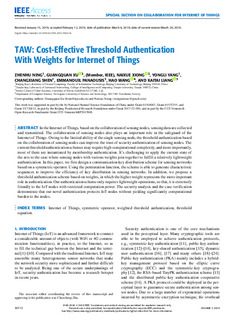TAW: Cost-Effective Threshold Authentication with Weights for Internet of Things
Ning, Zhenhu; Xu, Guangquan; Xiong, Naixue; Yang, Yongli; Shen, Changxiang; Panaousis, Emmanouil; Wang, Hao; Liang, Kaitai
Journal article, Peer reviewed
Published version

View/
Date
2019Metadata
Show full item recordCollections
Original version
10.1109/ACCESS.2019.2902226Abstract
In the Internet of Things, based on the collaboration of sensing nodes, sensing data are collected and transmitted. The collaboration of sensing nodes also plays an important role in the safeguard of the Internet of Things. Owing to the limited ability of the single sensing node, the threshold authentication based on the collaboration of sensing nodes can improve the trust of security authentication of sensing nodes. The current threshold authentication schemes may require high-computational complexity, and more importantly, most of them are instantiated by membership authentication. It's challenging to apply the current state of the arts to the case where sensing nodes with various weights join together to fulfill a relatively lightweight authentication. In this paper, we first design a communication key distribution scheme for sensing networks based on a symmetric operator. Using the permutation function, the scheme is able to generate characteristic sequences to improve the efficiency of key distribution in sensing networks. In addition, we propose a threshold authentication scheme based on weights, in which the higher weight represents the more important role in authentication. Our authentication scheme only requires lightweight operations, so that, it is extremely friendly to the IoT nodes with restricted computation power. The security analysis and the case verification demonstrate that our novel authentication protects IoT nodes without yielding significantly computational burden to the nodes.